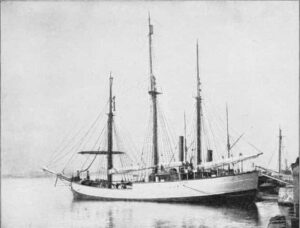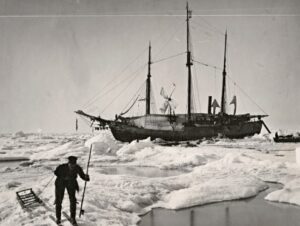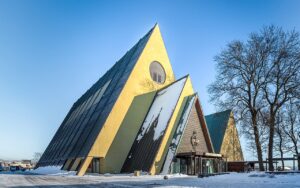
 It’s strange to think that someone would build a ship for the sole purpose of freezing it in the Artic ice sheet as a way of “floating” it over the North Pole, but that was exactly the plan when a ship named Fram (meaning Forward) was designed and built by the Scottish-Norwegian shipwright Colin Archer. The ship was built for Fridtjof Nansen’s 1893 Arctic expedition, to actually freeze it in the polar ice. The ship was a special design to be used in expeditions of the Arctic and Antarctic regions by the Norwegian explorers Fridtjof Nansen, Otto Sverdrup, Oscar Wisting, and Roald Amundsen between 1893 and 1912. Nansen’s ambition was to explore the Arctic farther north than anyone else, but he knew that they would be dealing with a problem that many sailing on the polar ocean had encountered before him, a problem that ended their expeditions…the freezing ice could crush a ship and end the expedition. The ship that was going to survive freezing in the Artic ice sheet, would have to be different…in just about every way. Nansen’s idea was to build a ship that could survive the pressure of the ice, not because it was stronger, but because it’s very shape would let the ice push the ship up, so it would actually “float” on top of the ice.
It’s strange to think that someone would build a ship for the sole purpose of freezing it in the Artic ice sheet as a way of “floating” it over the North Pole, but that was exactly the plan when a ship named Fram (meaning Forward) was designed and built by the Scottish-Norwegian shipwright Colin Archer. The ship was built for Fridtjof Nansen’s 1893 Arctic expedition, to actually freeze it in the polar ice. The ship was a special design to be used in expeditions of the Arctic and Antarctic regions by the Norwegian explorers Fridtjof Nansen, Otto Sverdrup, Oscar Wisting, and Roald Amundsen between 1893 and 1912. Nansen’s ambition was to explore the Arctic farther north than anyone else, but he knew that they would be dealing with a problem that many sailing on the polar ocean had encountered before him, a problem that ended their expeditions…the freezing ice could crush a ship and end the expedition. The ship that was going to survive freezing in the Artic ice sheet, would have to be different…in just about every way. Nansen’s idea was to build a ship that could survive the pressure of the ice, not because it was stronger, but because it’s very shape would let the ice push the ship up, so it would actually “float” on top of the ice.
Fram is a three-masted schooner with a total length of 127 feet 11 inches and width of 36 feet 1 inch. The ship was designed to be both unusually wide and unusually shallow in order to better withstand the forces of pressing ice. By design it would be able to push up through the ice to the top of the ice sheet, thereby allowing  it to float. Fram’s outer layer was made of, which can withstand the ice. It also had almost no keel so it could handle the shallow waters Nansen expected to encounter. The ship was designed with a retractable rudder and propeller, and it was carefully insulated to allow the crew to live on board for up to five years. A windmill was installed to run a generator that would provide electric power for lighting by electric arc lamps. The ship was launched on 26 October 1892. During the initial building process, Fram was fitted with a steam engine, which was fine, until something better came along. Then, before Amundsen’s expedition to the South Pole in 1910, the engine was replaced with a diesel engine, a first for polar exploration vessels.
it to float. Fram’s outer layer was made of, which can withstand the ice. It also had almost no keel so it could handle the shallow waters Nansen expected to encounter. The ship was designed with a retractable rudder and propeller, and it was carefully insulated to allow the crew to live on board for up to five years. A windmill was installed to run a generator that would provide electric power for lighting by electric arc lamps. The ship was launched on 26 October 1892. During the initial building process, Fram was fitted with a steam engine, which was fine, until something better came along. Then, before Amundsen’s expedition to the South Pole in 1910, the engine was replaced with a diesel engine, a first for polar exploration vessels.
Because of wreckage found at Greenland from USS Jeannette, which was lost off Siberia, and driftwood found in the regions of Svalbard and Greenland, Nansen had a theory that an ocean current flowed beneath the Arctic ice sheet from east to west, bringing driftwood from the Siberian region to Svalbard and further west. That was the main reason for building Fram. He wanted to order to explore this theory. His expedition ended up lasting three years, during which time, Nansen realized that Fram would not reach the North Pole directly. The current either wasn’t strong enough, or the polar ice was actually on land at the North Pole. So, he and Hjalmar Johansen set out to reach it on skis. After reaching 86° 14′ north, he had to turn back to spend the winter at Franz Joseph Land. During their expedition, Nansen and Johansen survived on walrus and polar bear meat and blubber. Finally, after they met up with British explorers from the Jackson-Harmsworth Expedition, they arrived back in Norway only days before the Fram also returned there. Their skiing mission was far more successful than the Fram’s mission, as the ship had spent nearly three years trapped in the ice, after only reaching 85° 57′ N. Fram made a scientific expedition to the Canadian Artic Archipelago between 1892 and 1902, and after being fitted with the diesel engine, Amundsen made his South Pole expedition from 1910 to 1912. Fram was 
 the first ship to reach the South Pole, during which Fram reached 78° 41′ S.
the first ship to reach the South Pole, during which Fram reached 78° 41′ S.
Following these expeditions, Fram was left to decay in storage from 1912 until the late 1920s. Then, Lars Christensen, Otto Sverdrup, and Oscar Wisting decide to begin an effort to preserve it by starting the Fram Committee. Finally, the now restored ship was installed in the Fram Museum in 1945, where it now stands.


One Response to The Fram